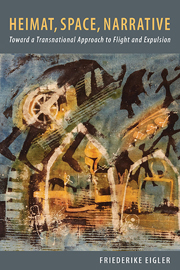Book contents
- Frontmatter
- Dedication
- Contents
- Acknowledgments
- Introduction: Geocritical Approaches to Place-Bound Belonging
- Part I Reassessing the Study of Heimat, Space, and Postwar Expulsion
- Part II Horst Bienek's Novels on Upper Silesia (1975–82)
- Part III Contemporary Novels
- 6 Writing (beyond) Memories of Loss: Novels by Christoph Hein, Reinhard Jirgl, Kathrin Schmidt, and Tanja Dückers
- 7 New Approaches to Flight and Expulsion: Border Regions in Novels by Sabrina Janesch and Olga Tokarczuk
- Conclusion: “Lived Spaces” in Literary Narratives
- Filmography
- Works Cited
- Index
7 - New Approaches to Flight and Expulsion: Border Regions in Novels by Sabrina Janesch and Olga Tokarczuk
from Part III - Contemporary Novels
Published online by Cambridge University Press: 05 August 2014
- Frontmatter
- Dedication
- Contents
- Acknowledgments
- Introduction: Geocritical Approaches to Place-Bound Belonging
- Part I Reassessing the Study of Heimat, Space, and Postwar Expulsion
- Part II Horst Bienek's Novels on Upper Silesia (1975–82)
- Part III Contemporary Novels
- 6 Writing (beyond) Memories of Loss: Novels by Christoph Hein, Reinhard Jirgl, Kathrin Schmidt, and Tanja Dückers
- 7 New Approaches to Flight and Expulsion: Border Regions in Novels by Sabrina Janesch and Olga Tokarczuk
- Conclusion: “Lived Spaces” in Literary Narratives
- Filmography
- Works Cited
- Index
Summary
As part of the dramatic social, cultural, and geopolitical transformation of these regions since the end of the Cold War, authors in East Central Europe are referencing and rewriting topographies of the Polish-Ukrainian border region (“Kresy”) and of Central Europe (“Mitteleuropa”). Authors such as Andrezej Stasiuk or Jurij Andruchovyc have examined the real and figurative location of regions within Europe, while others, such as Stefan Chwin and Olga Tokarczuk, have revisited the fraught personal and collective histories tied to German-Polish border regions or to formerly German cities such as Gdansk (Danzig). A few contemporary authors, including Olaf Müller, Tanja Dückers, and Sabrina Janesch, have recently engaged with some of these same cities and border regions as well. Their novels begin to challenge Orłowski's assessment of contemporary German literature, especially his claim that, unlike their Polish counterparts, German writers continue to be focused on memories and traumas of the past.
Within this larger European context, I look more closely at one Polish and one German novel, Olga Tokarczuk's Dom dzienny, dom nocny (House of Day, House of Night, 1998; German: Taghaus, Nachthaus) and Sabrina Janesch's Katzenberge (Cat Mountains, 2010). In different ways, both novels explore places of belonging in the liminal spaces of German-Polish border regions. Attachment to particular regions and places comes to the fore via their absence or loss. Both authors address the legacies of displacement due to flight and forced relocations in the context of the Second World War as well as efforts to establish new places of belonging in contemporary Poland.
- Type
- Chapter
- Information
- Heimat, Space, NarrativeToward a Transnational Approach to Flight and Expulsion, pp. 151 - 176Publisher: Boydell & BrewerPrint publication year: 2014

